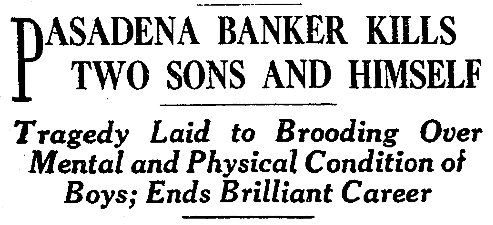

January 21, 1927
Los Angeles
Edward W. Xanders (aka Bert Best) was extradited from Portland, Oregon today to be tried for a series of robberies and burglaries committed in Los Angeles over the Christmas holidays.
 Xanders spent most of the day with sheriffs, trading quips and calmly confessing to a litany of misdeeds. He admitted to burglarizing the home of John Lindley near Azusa (see photo), and he has also said that he and his crime buddy, Ray E. McCoy, robbed famed boxing manager Jack Kearns.
Xanders spent most of the day with sheriffs, trading quips and calmly confessing to a litany of misdeeds. He admitted to burglarizing the home of John Lindley near Azusa (see photo), and he has also said that he and his crime buddy, Ray E. McCoy, robbed famed boxing manager Jack Kearns.
It was through his confession that police learned that Xanders and McCoy had stopped Kearns’ car on a lonely road near the beach. While the stick-up was in progress, a policeman had approached the car to see if the men needed assistance. McCoy jabbed a gun into Kearns’ ribs and told him to keep quiet, or die. Always the glib talker, Xanders chatted with the cop, offered him a cigar, and sent him on his way.
Xanders admitted to police that he had been in court a few times during 1926. He stated that he had been granted probation on a charge of assault with a deadly weapon. It was during that case that he had told the court that a childhood head injury had led him to a life of crime. According to his story, ever since he had received the blow to his noggin, he has had an irresistible urge to commit crime. Based on an alienist’s report, the judge recommended that Xanders, if willing, should undergo an operation to relieve pressure on his brain. Xanders declined to have the surgery.
With the nasty pressure still on his brain, it wasn’t long before Xanders was in court again. In making his plea for probation, he said that he’d been offered employment for two years on a ship headed for the South Seas. The judge felt compassion for the youthful crook and gave him four years of probation, on the condition that he would accept the job and sail off into the sunset (and out of this jurisdiction) for at least two years. Of course Edward never boarded the ship; he stayed in Los Angeles and continued his crime spree.
Edward is still a young man, and his penchant for crime may easily lead to another crack on the cranium. Maybe a second smack upside the head will put him on the straight and narrow.


 Despite there being a chance for a difference—Adams steadily asserted that the woman
Despite there being a chance for a difference—Adams steadily asserted that the woman 






 George and Mabel Drummond had nothing if not a tempestuous wedded life. Married ten years, hitched when George was fifteen and Mabel twenty-one, their stormy union included many a sterling instance, including the time a jealous Mabel held George in a chair at gunpoint for three hours while she threatened to shoot him with every passing moment.
George and Mabel Drummond had nothing if not a tempestuous wedded life. Married ten years, hitched when George was fifteen and Mabel twenty-one, their stormy union included many a sterling instance, including the time a jealous Mabel held George in a chair at gunpoint for three hours while she threatened to shoot him with every passing moment. Mabel was arrested by Detective Lieutenants Brown and Adams of University Station, who found her composed, and that she could only comment that if she couldn’t live with him, no-one could. When asked if she felt any regret, she replied:
Mabel was arrested by Detective Lieutenants Brown and Adams of University Station, who found her composed, and that she could only comment that if she couldn’t live with him, no-one could. When asked if she felt any regret, she replied:






 December 8, 1927
December 8, 1927 They walked and talked along the shady paths and across sun-dappled lawns until they came to the tennis court in the rear. It was 12:15 when father pulled out and brought a pistol to his son’s temple and fired. He was then seen sliding the barrel into his mouth and pulling the trigger, his body crumpling directly next to his son’s.
They walked and talked along the shady paths and across sun-dappled lawns until they came to the tennis court in the rear. It was 12:15 when father pulled out and brought a pistol to his son’s temple and fired. He was then seen sliding the barrel into his mouth and pulling the trigger, his body crumpling directly next to his son’s. Mrs. Margaret Pumphrey, 27, of the
Mrs. Margaret Pumphrey, 27, of the 
